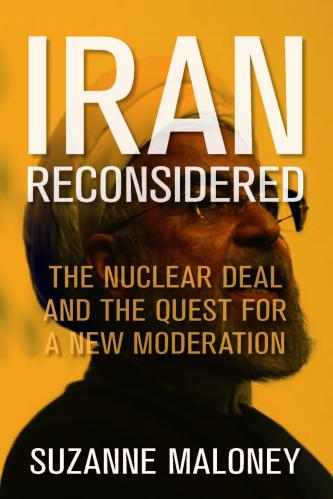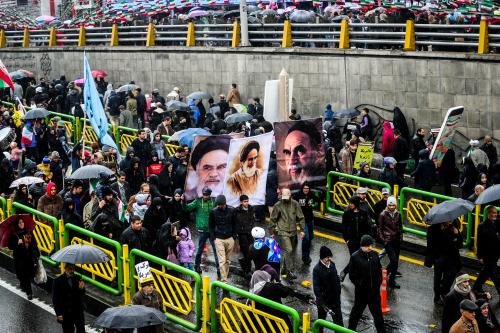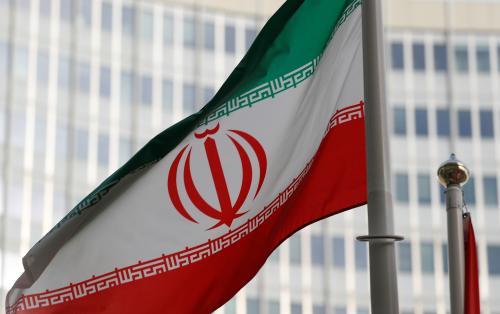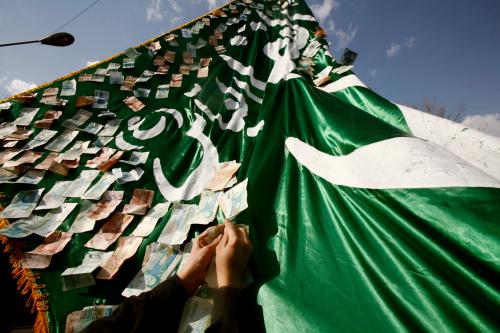Content from the Brookings Doha Center is now archived. In September 2021, after 14 years of impactful partnership, Brookings and the Brookings Doha Center announced that they were ending their affiliation. The Brookings Doha Center is now the Middle East Council on Global Affairs, a separate public policy institution based in Qatar.
If Iran were to hold a referendum on the Islamic Republic today, over 70% would clearly oppose it—among them the wealthy, academics, clerics, village, and city-dwellers. This remarkable hypothetical was not declared by an exiled Iranian dissident, but by the well-known Tehran political science professor, Sadegh Zibakalam, in an interview during the upheaval that took place in late 2017 and early 2018.
But how is it that even a formerly enthusiastic supporter of the Islamic Revolution has delivered such a devastating verdict? To understand this radical shift and the frustration behind it, we must revisit the promises that the revolution made four decades ago. The 1979 Iranian revolution promised three goals: social justice, freedom and democracy, and independence from great power tutelage.
Iran’s paradoxical quest for social justice
Framed in a Marxist–Islamist mindset, the revolution was made on behalf of the mostazafin—the downtrodden—who were left behind by the monarchy’s uneven development model. In the following four decades, intense controversy has erupted over the Islamic Republic’s socio-economic performance. While some claim that under the Islamist regime remarkable progress has been made, others depict an entire country mired in misery. More nuance and contextualization is needed.
Iran has indeed experienced progress over the last 40 years. Whether these successes have been a result of post-revolutionary policies, societal pressures, or the foundations laid by the shah remains hotly debated.
The shift from the shah’s pro-urban, elite-centered policies to a pro-rural and pro-poor (populist) approach under the Islamic Republic included expanding infrastructure and basic services—such as electricity and clean water—from cities to the countryside. In short, the revolution sought to eliminate the rural-urban divide. In rural Iran, the expansion of health and education led to a clear reduction in poverty: The 1970s poverty rate of 25% dropped to less than 10% in 2014. These social policies, biased in favor of the poor, help explain why Iran’s Human Development Index (HDI) has been relatively positive.
Unlike before the revolution, most Iranians today enjoy access to basic services and infrastructure, while the population has almost doubled and most of the country is urbanized. Other measures of social development have similarly improved. Literacy has more than doubled, especially among women, and now encompasses almost all the population. Meanwhile, female students have outnumbered their male counterparts at universities for more than a decade.
However, while statistics indicate that absolute poverty has declined sharply, a majority of Iranians continue to suffer from socio-economic precarity. Official sources state that 12 million live below the absolute poverty line and 25 to 30 million below the poverty line. Estimates suggest that one-third of Iranians, as well as 50 to 70% of workers, are in danger of falling into poverty. Fourteen percent of Iranians live in tents, according to the Statistical Center of Iran, and one-third of the urban population lives in slums. The living conditions of what anthropologist Shahram Khosravi calls Iran’s “other half,” or working-class poor, are striking: a 17-fold increase in the number of Iranians living in slums; 50% of the work force have only irregular employment; approximately 10 to 13 million Iranians “entirely excluded from health, work or unemployment insurance.”
And Iran’s socio-economic challenges cannot be separated from its political economy that favors regime loyalists and is marked by mismanagement, cronyism, nepotism, corruption, and the absence of much-needed structural reforms. Although U.S. sanctions have undoubtedly had negative repercussions, their overall impact on Iran’s economic situation is often overstated. For instance, in the summer of 2018, Hossein Raghfar, an economist at Tehran’s Allameh Tabataba’i University, has suggested that as little as 15% of Iran’s economic problems can be attributed to sanctions. The “illiberal neoliberalization” in various Iranian economic policies since the 1990s, featuring clientalistic privatizations and de-regulated labor market, has helped form nouveaux riches on one hand and precarious social strata on the other.
A chief failure of the Islamic Republic has been the lack of job creation, with jobless growth even increasing during oil booms. Unemployment rates remain high, especially among the youth, university graduates, and women. Officially, every eighth Iranian is unemployed. According to the Iranian parliament’s research center, the unemployment rate will reach 16% by 2021 in an optimistic scenario, 26% if conditions are less auspicious. Among the youth, one in four is unemployed (but some estimates go as high as 40%). These figures rank Iran’s youth unemployment rate as among the highest worldwide.
Iran’s Gini index of income inequality has remained consistently high at above 0.40, pointing to the lack of inclusive economic growth. Studying levels of inequality in pre- and post-revolutionary Iran, Djavad Salehi-Isfahani found that inequality in 2002 was about the same as in 1972, adding:
The findings on inequality raise important questions about the nature of the Islamic Revolution. Did it significantly affect the power structure as a social revolution of its magnitude should have? This is particularly relevant in the case of Iran because, in addition to changes in the distribution of productivity, the distribution of access to oil rents also affects inequality. Since access is directly related to political power, inequality may reflect the distribution of power. Thus, the finding that inequality in 2002 was about the same as in 1972 raises questions about the significance of the Islamic Revolution as a social and political revolution.
In other words, the class character of Iranian society has remained unchanged, with one ruling class replaced by another only with another social composition. In political cartoons, this was reflected in pictures of the shah’s crown merely being replaced by the mullahs’ turban. Such continuity led some scholars to interpret the 1979 revolution as merely a “passive revolution, a revolution without change” in class relations. Today, there is a strong public perception of high income inequality, given the ostentatious display of wealth and nepotism by the offspring of regime affiliates, the so-called âghâzâdeh, that Iranians observe on the streets of Tehran or on their smartphones through Instagram accounts like “Rich Kids of Tehran.”
The Islamic Republic’s relative achievements in the fields of rural infrastructure, education, and literacy, along with its failure to create jobs, have produced a socio-economic paradox that is politically explosive. Iran’s job market can simply not absorb the hundreds of thousands of university graduates. This paradox has produced a stratum of “middle-class poor,” as described by sociologist Asef Bayat. Defined as those with middle-class qualifications and aspirations but suffering from socio-economic precarity, this group was considered the social base of the 2017-18 uprising and is widely expected to continue to voice its anger and frustration.
On the situation of Iran’s youth under the Islamic Republic, Bayat explained in a 2016 interview:
The youth not only want a secure future—that is reasonable jobs, a place to live, get married, and form a family in the future—they also want to reclaim their “youthfulness,” a desire to live the life of youth, to pursue their interests, their individuality, free from the watchful eyes of their elders, from moral and political authority. This dimension of young people’s lives adds to the existing social tensions in Iran.
As alluded to before, Iranians face another structural impediment to socio-economic opportunities. Regime “insiders” (khodi) or those with access to state resources and privileges also enjoy privileged access to jobs. These frustrations have led many young Iranians to vote with their feet. Even under the Rouhani administration, Iran has continued to experience world record-breaking levels of brain drain, losing an estimated $150 billion per year.
Political freedom and democracy
In addition to social justice, the architects of the 1979 revolution contended that the ouster of the monarchy would usher in greater freedom. However, the brief post-revolutionary euphoria and sense of liberation quickly gave way to the new rulers’ systemic Islamization of state and society. That one dictatorship was replaced by another, and by an even more brutal one, became apparent in the Islamic Republic’s first decade. Between 1981 and 1985, nearly 8,000 people were executed, and similar numbers were killed during the so-called “great massacre” in the final year of the 1980–88 war with Iraq. By contrast, in the eight years preceding the revolution (1971-79), fewer than 100 political prisoners were executed. The Islamic Republic became one of the most repressive systems on the globe, more recently with the world’s highest execution rate.
In this process, modern Iran’s three dominant politico-ideological formations, or political cultures—namely nationalism, socialism, and Islamism—were narrowed to heavy emphasis on the latter, which managed to incorporate elements of the others. Although there is some variety, the new political elite is largely limited to various stripes of Islamism. The revolutionary movement’s political pluralism has been suppressed, with no veritable opposition party allowed by the state.
Likewise, Iranian civil society’s constitutive movements—women, students, and labor—have faced systemic repression, undermining their organizational capacities and leaving Iran’s dynamic civil society weak compared to the state. State repression has also targeted dissidents of various ideological persuasions, non-Persian minorities, and journalists. Iran today is one of the world’s leading jailers of journalists, ranked 170th among 180 by Reporters Without Borders. While the Islamic Republic’s press landscape displays a remarkable degree of vibrancy and openness within the system’s redlines, the hardline-dominated judiciary has regularly banned publications and imprisoned journalists.
Overturning the existing monarchical order, the Islamic Republic established a peculiar political system that is conventionally understood to be based on two pillars: theocratic (with the supreme leader at the top as the head of state) and republican (with an elected parliament and president). However, the latter is at best semi-republican, as the Guardian Council only allows candidates deemed loyal to the Islamic Republic to run for office. This unique configuration has been a key impediment for the creation of democracy; non-elected institutions still dominate, while elected ones have remained faithful to the system. Most importantly, the Islamic Republic’s hybrid authoritarianism has shown remarkable resilience against meaningful political change, leading to widespread popular frustration today with both regime wings—the so-called moderates as well as the hardliners.
Independence inseparable from freedom
The revolution’s fervent opposition to both Cold War superpowers, the United States and the Soviet Union, was encapsulated in the revolutionary slogan “Neither West, nor East, [only] the Islamic Republic.” But it was the revolution’s animosity toward Washington that has dominated Iran’s international relations. And while Iran has found itself in a geopolitical confrontation with the West, it was never geopolitically integrated into the East. Instead, as the policies of Russia, China, and India during heightened U.S. sanctions have demonstrated, Iran has found itself forced to give concessions to Asian great powers that have consistently prioritized their ties with Washington over those with Tehran. As a result, Iran has experienced new patterns of dependency on those Eastern great powers, since confronting them is not an option so long as Tehran is at loggerheads with the international system’s most powerful state.
Iran has experienced new patterns of dependency on those Eastern great powers, since confronting them is not an option so long as Tehran is at loggerheads with the international system’s most powerful state.
Against this backdrop, how can Iranians safeguard their longstanding desire for independence in a 21st-century, interdependent world? Ruhollah Ramazani, the late doyen of Iranian foreign policy studies, rightly emphasized that in an interdependent world, there is no such thing as absolute independence, but rather degrees of dependence. In other words, Iran’s national development will suffer if today it tries to maintain a fervent, ideological adherence to an abstract notion of absolute independence.
Iran’s domestic authoritarian context poses another formidable challenge for safeguarding independence, as it favors close ties with authoritarian rather than democratic states. The hardline custodians of the Islamic Republic need not fear that like-minded authoritarian regimes, like China and Russia, will introduce issues like human rights and democracy in bilateral relations. The result is a geopolitical preference for a “Look to the East” policy, mostly favored by those forces who stand to benefit politically and economically from such an orientation. The shadow of Iran’s antagonism with the United States has sustained its conflictual relationship with the Western world. This has not only prevented it from developing its full potential by building robust ties with both the West and the East, but has pushed the country into the hands of the latter powers who have abused Iran’s isolation from the West and its need of the East. For this reason, Ramazani aptly noted that a democratic polity is a necessary precondition to prevent dependency, noting that “the breakdown of the rule of law and politicized judiciary will ultimately undercut Iran’s ability to maintain its independence in world politics.” He also emphasized that freedom and independence are inseparable.
A more open political climate, as in India for example, would allow for domestic debates about foreign policy choices and the stakes involved for the population. Hence, democratization would significantly improve Iran’s international image and potentially improve its bargaining power vis-à-vis great powers, especially given Western powers’ tendency towards instrumentalizing human rights in order to generate political pressure.
Conclusion
So did the Iranian revolution eventually deliver on its promises? Despite some achievements, the overall picture looks bleak, particularly when it comes to promises of democracy. Whether that is reversible is another difficult question. The acute triple crisis—socio-economic, political, and ecological—the Islamic Republic faces in its 40th year, a growing sense of popular disillusionment and frustration that forcefully erupted during the 2017-18 upheaval, and the ongoing confrontation with the world’s most powerful state leaves little hope that the same system that failed to deliver on these promises for decades will succeed in the future.






Commentary
Four decades later, did the Iranian revolution fulfill its promises?
July 11, 2019